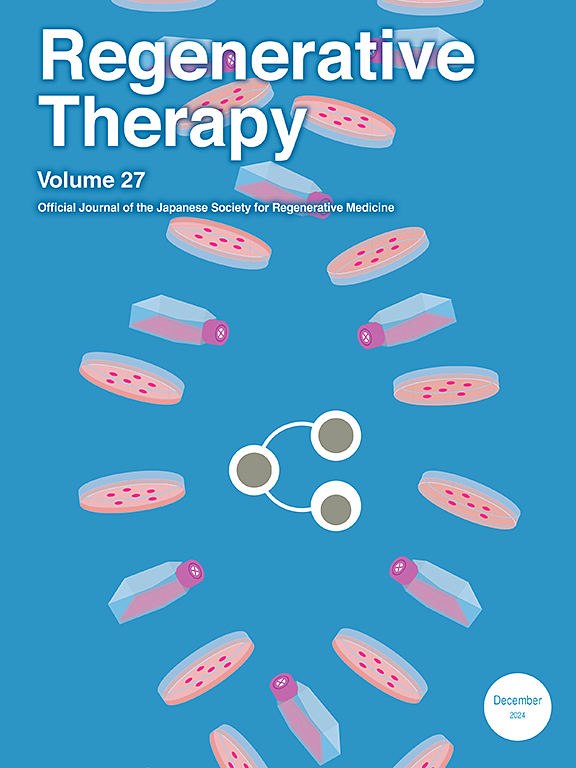通过清除细胞外HMGB1抑制TLR4/RAGE通路是放射损伤唾液腺的潜在治疗靶点
IF 3.5
3区 环境科学与生态学
Q3 CELL & TISSUE ENGINEERING
引用次数: 0
摘要
我们最近开发了一种使用有效单核细胞(E-MNCs)的新疗法,并证明了其治疗放射损伤的唾液腺(SGs)的有效性。E-MNCs的活性部分涉及免疫调节-CD11b/巨噬细胞清道夫受体1(Msr1)- m2阳性巨噬细胞,其通过吞噬清除细胞外高迁移率组盒1(HMGB1)发挥抗炎和组织再生作用。针对这一现象,本研究探讨了调节HMGB1/toll样受体4 (TLR4)/晚期糖基化终产物受体(RAGE)信号通路在治疗辐射损伤所致SG功能障碍中的意义。方法将se - mncs移植到辐射损伤小鼠的SGs中,观察TLR4/RAGE的表达变化。此外,我们还研究了辐照后完整SG和培养SG上皮细胞的下游信号激活情况。随后,采用TLR4敲除(KO)小鼠研究HMGB1/TLR4/RAGE信号传导如何影响损伤进展。结果在E-MNC移植损伤SGs的导管细胞和巨噬细胞/血管内皮细胞中,TLR4和RAGE的表达均降低。同时,受损SGs中TLR2/4和RAGE的表达显著升高,与细胞外HMGB1积累相关。激活下游信号,观察导管细胞中磷酸化核因子κ B (p-NF-KB)的核内定位以及IL-6、肿瘤坏死因子-α (TNF-α)和干扰素-γ (IFN-γ)的产生。此外,辐照培养的SG上皮细胞的培养上清含有受损相关分子模式(DAMP)/衰老相关分泌表型(SASP)因子。用该上清液处理培养的SG上皮细胞,激活TLR4信号通路,诱导细胞衰老。在TLR4-KO小鼠中,放射源性SG功能障碍的发生明显延迟。然而,TLR2/RAGE信号被交替激活,SG功能受损。结论清除HMGB1等DAMPs可能通过抑制TLR4/RAGE信号通路减轻受损SGs无菌性炎症。这种细胞机制可能对未来基于细胞的再生疗法的发展具有重要意义。本文章由计算机程序翻译,如有差异,请以英文原文为准。
Inhibition of the TLR4/RAGE pathway by clearance of extracellular HMGB1 is a potential therapeutic target for radiation-damaged salivary glands
Introduction
We recently developed a new therapy using effective-mononuclear cells (E-MNCs) and demonstrated its efficacy in treating radiation-damaged salivary glands (SGs). The activity of E-MNCs in part involves constituent immunoregulatory -CD11b/macrophage scavenger receptor 1(Msr1)-positive-M2 macrophages, which exert anti-inflammatory and tissue-regenerating effects via phagocytic clearance of extracellular high mobility group box 1 (HMGB1). Focusing on the phenomena, this study investigated significance of regulating the HMGB1/toll-like receptor 4 (TLR4)/receptor for advanced glycation end products (RAGE) signaling pathway in the treatment of SG dysfunction caused by radiation damage.
Methods
E-MNCs were transplanted into radiation-damaged mice SGs, and changes of TLR4/RAGE expression were observed. Furthermore, the activation of downstream signals was investigated in both intact SGs and cultured SG epithelial cells after irradiation. Subsequently, TLR4-knock-out (KO) mice were employed to examine how HMGB1/TLR4/RAGE signaling affected damage progression.
Results
Expression of both TLR4 and RAGE was diminished in ductal cells and macrophages/vascular endothelial cells of damaged SGs with E-MNC transplantation, respectively. Meanwhile, expression of TLR2/4 and RAGE in damaged SGs markedly increased in association with extracellular HMGB1 accumulation. Downstream signals were activated, and intranuclear localization of phospho-nuclear factor-kappa B (p–NF–KB) in ductal cells and production of IL-6, tumor necrosis factor-α (TNF-α), and interferon-γ (IFN-γ) were observed. Additionally, culture supernatant of irradiated cultured SG epithelial cells contained damaged associated molecular pattern (DAMP)/senescence-associated secretory phenotype (SASP) factors. Treatment of cultured SG epithelial cells with this supernatant activated TLR4 signaling pathway and induced cellular senescence. In TLR4-KO mice, onset of radiogenic SG dysfunction was markedly delayed. However, TLR2/RAGE signalings were alternatively activated, and SG function was impaired.
Conclusions
Clearance of DAMPs such as HMGB1 may attenuate sterile inflammation in damaged SGs via suppression of the TLR4/RAGE signaling pathway. This cellular mechanism may have significant implications for the development of future cell-based regenerative therapies.
求助全文
通过发布文献求助,成功后即可免费获取论文全文。
去求助
来源期刊

Regenerative Therapy
Engineering-Biomedical Engineering
CiteScore
6.00
自引率
2.30%
发文量
106
审稿时长
49 days
期刊介绍:
Regenerative Therapy is the official peer-reviewed online journal of the Japanese Society for Regenerative Medicine.
Regenerative Therapy is a multidisciplinary journal that publishes original articles and reviews of basic research, clinical translation, industrial development, and regulatory issues focusing on stem cell biology, tissue engineering, and regenerative medicine.
 求助内容:
求助内容: 应助结果提醒方式:
应助结果提醒方式:


